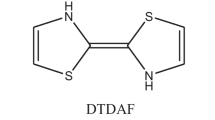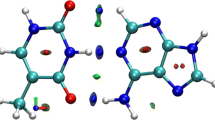Abstract
In this work, we have investigated the dihydrogen bond interaction of adenine, cytosine, guanine and thymine with H–M (M = Li and Na) complexes to reveal the nature of N–H⋅⋅⋅H–M type using density functional theory (DFT). The structural parameters illustrate that the thymine⋅⋅⋅H–Li complex has the smallest dihydrogen bond distance while the analysis of infrared vibrational frequencies confirmed that all the considered structures belong to true local minima. The natural bond orbital (NBO) analysis was done to evaluate the charge delocalization in intermolecular donor-acceptor interaction for all the complexes. The quantum theory of atom in molecule (QTAIM) and non-covalent interaction (NCI)-reduced density gradient (RDG) approaches were used to describe the nature of interaction. Along with molecular electrostatic potential (MEP), we have also studied Mulliken population analysis to explore the existence of dihydrogen bonded interactions. Besides, localized molecular orbital-energy decomposition analysis (LMO-EDA) was also employed to comprehend the dominant energy components and the nature of H⋅⋅⋅H interaction.




Similar content being viewed by others
REFERENCES
Q. Li, X. Dong, X. An, B. Gong, and J. Cheng, J. Comput. Chem. 6, 776 (2009).
P. D. Duraisamy, P. Gopalan, and A. Angamuthu, Monatsh. Chem. 151, 1569 (2020).
A. Allouche, J. Comput. Chem. 32, 174 (2012).
A. H. Pakiari and A. Mohajeri, J. Mol. Struct.: THEOCHEM 620, 31 (2003).
Y. Yang, Y. Liu, D. Yang, H. Li, and J. Sun, Phys. Chem. Chem. Phys. 17, 32132 (2015).
V. I. Bakhmutov, Dihydrogen Bonds: Principles, Experiments, and Applications (Wiley, New York, 2007).
G. N. Patwari, T. Ebata, and N. Mikami, J. Chem. Phys. 116, 6056 (2002).
S. J. Grabowski, Chem. Phys. Lett. 327, 203 (2000).
A. H. Pakiari and Z. Jamshidi, J. Mol. Struct.: THEOCHEM 685, 155 (2004).
A. Singh, D. K. Sahoo, S. K. Sethi, et al., Chem. Phys. Chem. 18, 3625 (2017).
J. Fanfrlík, M. Lepšík, D. Horinek, et al., Chem. Phys. Chem. 7, 1100 (2006).
N. V. Belkova, L. M. Epstein, O. A. Filippov, and E. S. Shubina, Chem. Rev. 116, 8545 (2016).
R. Custelcean and J. E. Jackson, Chem. Rev. 101, 1963 (2001).
B. G. de Oliveira, Phys. Chem. Chem. Phys. 15, 37 (2013).
Y. Marechal, The Hydrogen Bond and the Water Molecule (Elsevier, Amsterdam, 2007).
N. Špačková, I. Berger, and J. Šponer, J. Am. Chem. Soc. 123, 3295 (2001).
O. A. Stasyuk, M. Solà, M. Swart, et al., Chem. Phys. Chem. 21, 2112 (2020).
K. J. Koch, T. Aggerholm, S. C. Nanita, and R. G. Cooks, J. Mass Spectrom. 37, 676 (2002).
M. T. Rodgers and P. B. Armentrout, J. Am. Chem. Soc. 122, 8548 (2000).
A. D. Becke, J. Chem. Phys. 98, 5648 (1993).
C. Lee, W. Yang, and R. G. Parr, Phys. Rev. B 37, 785 (1988).
R. Krishnan, J. S. Binkley, R. Seeger, and J. A. Pople, J. Chem. Phys. 72, 650 (1980).
S. F. Boys and F. Bernardi, Mol. Phys. 19, 553 (1970).
A. N. Isaev, Russ. J. Phys. Chem. A 90, 601 (2016).
Siyamak Shahab, M. Sheikhi, L. Filippovich, et al., Russ. J. Phys. Chem. A 94, 1848 (2020).
T. Lu and F. Chen, J. Comput. Chem. 33, 580 (2012).
W. Humphrey, A. Dalke, and K. Schulten, J. Mol. Graphics 14, 33 (1996).
C. E. Dykstra, G. Frenking, K. S. Kim, and G. E. Scuseria, Theory Appl. Comput. Chem., 1185 (2005).
M. W. Schmidt, K. K. Baldridge, J. A. Boatz, S. T. Elbert, M. S. Gordon, J. H. Jensen, S. Koseki, N. Matsunaga, K. A. Nguyen, S. Su, T. L. Windus, M. Dupuis, and J. A. Montgomery, J. Comput. Chem. 14, 1347 (1993).
M. J. Frisch et al., Gaussian 09, Revision B.1 (Gaussian Inc., Wallingford, CT, 2009).
ChemCraft, Vers. 1.8. http://www.chemcraftprog.com.
P. D. Duraisamy, P. Gopalan, and A. Angamuthu, Chem. Pap. 74, 1609 (2020).
K. Verma and K. S. Viswanathan, Phys. Chem. Chem. Phys. 19, 19067 (2017).
B. G. Oliveira, Comput. Theor. Chem. 998, 173 (2012).
M. Prabhaharan, A. R. Prabakaran, S. Srinivasan, and S. Gunasekaran, Spectrochim. Acta, Part A 127, 454 (2014).
S. J. Grabowski, W. A. Sokalski and J. Leszczynski, Chem. Phys. Lett. 432, 33 (2006).
S. J. Grabowski, J. Phys. Chem. A 111, 3387 (2007).
N. S. Venkataramanan, A. Suvitha, and Y. Kawazoe, J. Mol. Liq. 260, 18 (2018).
ACKNOWLEDGMENTS
The authors gratefully thankful to “Bioinformatics resources and applications facility (BRAF), C-DAC, Pune” for providing the computational facilities for this work. Also, acknowledge the offering workstation from Computer Technology Centre (CTC) at KITS.
Author information
Authors and Affiliations
Corresponding author
Ethics declarations
The authors declare that they have no conflicts of interest.
Rights and permissions
About this article
Cite this article
Duraisamy, P., Gopalan, P. & Angamuthu, A. Investigation of N–H⋅⋅⋅H–M Dihydrogen Bonded Interactions in Adenine, Cytosine, Guanine, and Thymine with H–M (M = Li and Na) Complexes: A DFT Study. Russ. J. Phys. Chem. 96, 1258–1267 (2022). https://doi.org/10.1134/S0036024422060176
Received:
Revised:
Accepted:
Published:
Issue Date:
DOI: https://doi.org/10.1134/S0036024422060176




